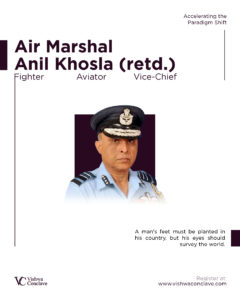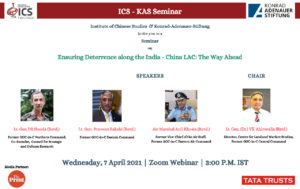BOOK REVIEW
1962 BORDER WAR SINO-INDIAN TERRITORIAL DISPUTES AND BEYOND
– By Ismail Vergasseri
Review by: Air Marshal Anil Khosla (Retd) PVSM, AVSM, VM
China has always been an enigma and is considered to be mysterious riddle to be solved. Her aggressive and belligerent approach and attitude towards the world at large and India in particular during the time of the pandemic has left everyone wondering about her psyche. Scholars have attributed several reasons to it, which include opportunism, power intoxication, diversion of attention and desperation seeing the dream of rejuvenation slipping away.
Sixty years ago, on October 20, 1962 China attacked India, apparently provoked by a territorial dispute and tensions over Tibet. The war was brief however, it affected the psyche of both countries and still casts a long shadow over Sino-Indian relations. The historical imprint of the war still affects the attitude and decision making process of the two countries. Like all wars, the 1962 war between China and India had multiple causes. These factors need to be examined dispassionately to learn lessons for the future.
The relationship between the two countries was cordial till about 1950 in spite of existing disputed boundaries. Numerous factors led to souring of relations between the two Asian giants finally leading to the armed conflict in 1962. Recent India-China stand-off has generated a renewed interest and debate about the Sino-India relations. The publication of the book on “1962 Border war Sino-Indian territorial disputes and beyond” by Ismail Vergasseri is timely and useful in correlating the present situation with the past as it reveals the historical factors which shaped the Sino-Indian relations and reason for frequent skirmishes along the border. It is a useful book as it revisits the important topic and helps in understanding how such a brief and limited conflict, has had such immense and long lasting political and other consequences. India still sees China as a nationalist, aggressive power which seeks to dominate Asia and one that might once again strike unexpectedly, just as it did in 1962.
This 284 page book is a work of contemporary history dealing with the 1962 Sino-Indian war. It brings out historical time lines of relations between the two nations and the factors responsible for souring of relations leading up to the war. The book is divided into nine chapters critically analysing each factor. The work is interdisciplinary in nature and has good references for further research. The author has carried out an analytical study dealing with the subject comprehensively, bringing out the complexities in a lucid manner with absolute clarity. In the end he has summarised it very well listing out the conclusions and making valuable recommendations.
In the initial part, the book looks at the available literature on the subject and explains the topography of the area. The author has analysed all the available literature and records in detail. Primary source of the study includes the Henderson Brooks-Bhaga-Report, the official history of conflict with China brought out by GOI, CIA report on Sino-India border dispute, MEA documents on treaties and agreements and digital documents included in historical archives of USA.
The topographic review brings out that there is no clearly delineated and marked boundary or accepted line of actual control between the two countries. This causes tension and friction quite often. Sino-Indian border runs along the high altitude of Himalayas and major portion of it is un-demarcated, hardly habitable and inaccessible with steep creeks and deep valleys. It is divided into three sectors: western, central and eastern. Western Sector includes the border between Jammu and Kashmir and Xinjiang and Tibet. India claims that China is illegally occupying large area of land in this sector, including area ceded to it by Pakistan. Central Sector includes borders shared by Himachal Pradesh and Uttrakhand with Tibet. In eastern Sector China disputes India’s sovereignty over entire Arunachal Pradesh.
The book covers in great detail the origin and development of border disputes, highlighting that the seeds of dispute were sown due to colonial game played by the British. The origin of the two major disputed areas Aksai Chin and Mc Mahon Line has been deliberated comprehensively, labelling it appropriately as cartographic mischief. It brings out that the British India’s frontier policies had failed to produce a single integrated and well-defined northern boundary separating the Indian subcontinent from Xinjiang and Tibet.
It has been rightly observed in the book that the two countries started drifting apart due to the Tibet issue. Long before the war Tibet began to plague Beijing and Delhi’s relationship as China accused India of trying to undermine its rule in Tibet while India charged China with suppressing Tibetan autonomy. Tibetan Uprising in 1954 and the Dalai Lama seeking refuge in India changed the situation for the worse. China’s perception of India as a threat to its rule of Tibet became one of the most prominent reasons for the Sino-Indian War. The Tibet factor combined with few other issues pushed the two nations towards war. However, the war of 1962 sealed the fate of the Tibet issue and it became an eternal source of tension in Sino-Indian relations. The main reason attributed to the cause of the war was dispute over the sovereignty of the widely separated Aksai Chin and Arunachal Pradesh border regions. India claimed at Aksai Chin belonged to Ladakh whereas, China claimed it to be part of Xinjiang.
The book also brings out the ulterior forces that acted as a catalyst in spoiling the relations. Role of disruptive elements within polity, internal bureaucratic hurdles, political intrigues and partisan interest has been deliberated. Clandestine work of external forces including impact of Cold War politics, CIA operations on the frontiers and the US strategy of projecting the Tibet factor on these two nations has been revealed. Even the role of Indian press, political opposition and the parliamentary debates has been flagged. Several attempts to resolve the issues are listed chronologically in the book. Indian response was generally accommodating and conciliatory in the spirit of Panch Sheel, however, these attempts did not resolve the issues. It has been concluded that colonial interventions did upset the bilateral relations further.
Military aspects of the war have also been briefly touched upon in the book calling it a military debacle. It was a debacle due to diplomatic miscalculations, poor defence-preparedness and wrong leadership decisions. The Henderson Brooks-Bhagat Report on the 1962 India-China war, essentially blames the military leadership and intelligence apparatus for the debacle. However, the political leadership was convinced in their minds that there would be no large-scaled armed conflict or full-scale war.
Important part of the book is the final conclusion. It has been concluded correctly and summarised that the war served no purpose at all in resolving the issue. Actually it further aggravated the situation and deteriorated the bilateral relations. It also left the region divided, encouraging an arms race and increased military spending. The war has instilled deep mistrust and a strong sense of rivalry between the two sides. To this day China continues to claim the Indian state of Arunachal Pradesh, while New Delhi lays claim to the Chinese-controlled Aksai Chin territory. This dispute continues to prevent the full normalization of relations. The book also brings out a lesson which is even relevant in present day situation that militarisation and military solution is not an answer to bilateral border disputes. Solution lies in diplomatic talks and negotiations in the spirit of give and take. Both countries have a lot to lose from a confrontation and an overt armed struggle.
Overall it is a comprehensive research work covering all aspects related to a relevant subject. The multi-disciplinary book is appropriately timed, and is beneficial to people from diverse background. It will be useful for China watchers, analysts, military strategists, security mandarins, political scientists, diplomats, historians and students & scholars of regional security.
For regular updates please register here –
https://55nda.com/blogs/anil-khosla/subscribe/





